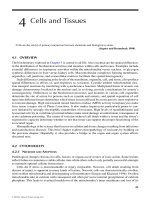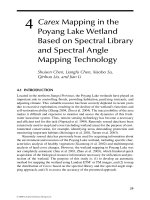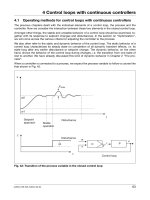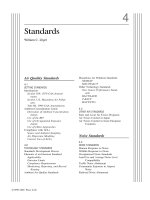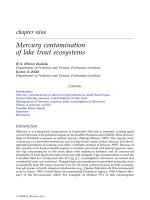LANDSCAPE ECOLOGY A Top-Down Approach - Chapter 4 pps
Bạn đang xem bản rút gọn của tài liệu. Xem và tải ngay bản đầy đủ của tài liệu tại đây (181.44 KB, 11 trang )
© 2000 by CRC Press LLC
4
Landforms and Landscapes
Jim Sanderson and Larry D. Harris
CONTENTS
Landforms and Geological Processes
Relief-Forming Mechanisms and Their Effect on the Biota
Biotic Processes
Landscape Processes
Zoogeomorphology and the Influence of Wildlife on Ecosystem
Dynamics
Landscape Conservation
Exercises
Understanding landforms and geomorphological processes is necessary to
understanding the ecology of landscapes (Swanson et al. 1988). Rainshadows
caused by the interaction of wind and mountains are but one obvious exam
-
ple of why landforms are important to the biota. Landforms effect the flow of
energy and material that support life. Landform gradients can deliver water
to wildlife or act to constrain their migratory paths. Appreciating the influ
-
ence of landforms and climate on soil, vegetation, and wildlife is a familiar
bottom-up path to gaining an appreciation for landscape ecology.
Landforms and Geological Processes
The relief sphere or outer boundary of the crust of the earth is the boundary
between the atmosphere and the solid crust or lithosphere. About 71% of the
relief sphere is covered by oceans. Geomorphology is the study of the genesis
and history of landforms, or more precisely, of the subaerial relief sphere, pres
-
ently 26% of the surface of the earth exposed directly to the atmosphere (not
covered by ice or sea) where higher plants and animals evolved and where
humans live (Büdel 1982). The shape of landforms is actively molded by plate
© 2000 by CRC Press LLC
tectonic volcanic and exogenous processes last derived ultimately from solar
energy that is converted to heat energy mainly at the surface of the earth. The
appearance of landforms varies with climate.
The relief sphere of the earth is covered by an atmosphere some 800 km
thick. All processes of radiation, wind movement, pressure waves, and other
changes in the atmosphere, and all surface and deep-water currents, tidal
movements, swells, convection, and internal waves in the ocean are ephem
-
eral processes that leave little or no lasting evidence in the atmosphere or
ocean. Only in the crust of the earth and sea sediments are past events some
-
times recorded. Before Rutimeyer (1874) demonstrated that valleys were not
cracks in the crust, but instead were hollowed by water, the relief sphere was
thought to be formed by purely endogenic processes such as crustal move
-
ments (Lyell 1830 to 1833). We now know that two often related endogenic
processes have direct influence on landform relief, and these are associated
with volcanic events (cones, craters, and calderas) or plate tectonic move
-
ments. In both cases exogenic processes work to change the external appear-
ances of landforms.
Processes that affect landforms, so-called relief-forming mechanisms,
derive their energy from short-wave radiation impinging upon and heating
the relief sphere. While radiation penetrates water, on land the conversion is
intense and confined to a relatively thin layer. Whereas water mixes heat rap
-
idly and thus distributes energy over a greater extent, landforms are heated
directly and the heat is transported downward, but no deeper than 10 to 12
m below the surface where annual temperature fluctuations cease. All pro
-
cesses associated with weather and climate are therefore governed by the
relief sphere. Climatic effects set off far-reaching energy conversions that cre
-
ate relief-forming mechanisms that ultimately shape landforms.
Relief-forming mechanisms are classified as either stable elements such as
insolation, evaporation, and precipitation or mobile elements such as ero
-
sion, transportation, and deposition. The relief sphere is struck by insolation
and warmed, causing evaporation and hence precipitation, the influence of
which depends ultimately on the form (solid or liquid) taken. Evaporation is
a proximate effect, giving rise to deserts and, together with wind, causing
other areas to receive moisture. Moist air is transported by the atmospheric
currents and precipitation is deposited according to well-understood princi
-
ples. Precipitation can penetrate the earth and cause mechanical and chemi-
cal changes. Water is the main agent causing bedrock decomposition that
aids in soil formation. In the humid tropics water causes chemical weathering
and in the high latitudes water in the form of permafrost causes mechanical
change, breaking down rock in situ.
The mobile relief-forming mechanisms represent the final stage in energy
conversions of landforms and transform the endogenous form into the exo
-
genic landforms we see today (Figure 4.1). Areal and slope erosion are the
most obvious examples of mobile mechanisms, and the great valleys that
cover many areas have resulted from erosion. Indeed, most relief develop
-
ment is involved with creating concavities (Büdel 1982). Material is worn
© 2000 by CRC Press LLC
down and then transported by wind or water elsewhere. Rivers deliver sus-
pended material to the sea, and while some material is dropped quickly, the
finest material such as clay can be carried far out to sea and deposition takes
place in the deep ocean. The erosional power of wind is also well known. In
the Botku Mountains of Chad, 700 km northeast of Lake Chad, wind has
stripped away the soil and is abrasively wearing away the exposed bedrock.
Wind is also a depositional process. Great Sand Dunes National Monument
in southern Colorado exists because wind carries fine sand particles, sorting
them for many kilometers, and depositing the nearly uniform grains into
great piles before rising over the San Juan Mountains.
With few exceptions, the landforms we see today are the products of an
ancient past. The Sahara Desert once resided at the magnetic South Pole and
was covered by ice. India changed hemispheres. The Himalayas continue to
rise upward and be eroded downward. Land now free from kilometers of
thick ice rises and will sink during the next glacial advance. Tidewater gla
-
ciers advance and retreat. Oxbow lakes are formed and reformed as water
from the Andes finds the sea. These processes acting on landforms at differ
-
ing time scales create the stage upon which the thin veneer of biotic life exists.
The theater that contains the stage is also dynamic, but on much longer time
scales.
Tricart (1965) created a table classifying geomorphological features. For our
purposes Table 4.1 links the time required to effect change on an area of the
surface of the earth by well-understood processes. The importance of Table
4.1 from an ecological viewpoint is that many landscapes have changed dra
-
matically even over the last ten years principally by the acts of humans and
not by geological or lithographic processes. In other words, in creating a
reserve or protected area we should not dwell on how the landform beneath
the biota will change. Instead, anthropocentric effects are occurring over
much faster time spans and should be of central concern.
FIGURE 4.1
Endogenous tectonic forces have created a dome-shaped mountain that has risen over tens of
millions of years. The mountain’s internal structure is highly folded due to unequal uplifting
forces. The exogenic actual shape is jagged and worn down, transformed into valleys whose
material wears faster than do neighboring peaks. Landforms we see today are being actively
shaped by exogenic mechanisms, such as erosion, transportation, and deposition.
© 2000 by CRC Press LLC
Though the composition of the atmosphere has been changed by the biota,
the circulation patterns are governed by planetary forces such as the Coriolis
Force, and the resulting Hadley, Ferrel, and Polar cells. The flow of atmo
-
spheric currents and the three-dimensional form of the relief sphere deter-
mine the location of the deserts, rainshadows, and wet areas even in the
absence of life (Figure 4.2). Global ocean currents are also unaffected by the
biota. The Coriolis Force, surface winds, ice sheets, and the location of the
continents determine ocean currents. The ocean transports energy in the form
of heat to the high latitudes, from the low equatorial latitudes moderating the
global climate. Though surface winds may change direction, the long-term
climate memory of the earth lays within the ocean currents. Atmospheric
winds and ocean currents continuously recycle air and water. Moisture-laden
air arising from evaporation over the oceans is transported by surface winds
over land where precipitation occurs. Ocean water recycles CO
2
and other
gases in the air. Indeed, the ocean bottom is the largest storage of carbon in
the form of limestone (CaCO
3
) on the planet. Living organisms with shells
formed the limestone sequestering the carbon.
TABL E 4 .1
Geomorphogic processes operate on time spans that change landform features.
Generally, the larger the area affected the longer terrestrial processes require to
effect change. (From Tricart 1965.)
Area (km
2
) Example Process Time span (years)
10
7
Ocean basin Plate tectonics 10
9
10
6
Scandinavian shield Crustal movements 10
8
10
4
–10
2
Mountain massifs Smaller tectonic movements 10
7
10 Va lleys Lithography 10
6
10
-2
Moraines, ridges Lithography, wind 10
4
10
-6
Badland gullies Microlithography 10
2
FIGURE 4.2
The climate system of the earth would still exist even in the absence of life.
© 2000 by CRC Press LLC
Relief-Forming Mechanisms and Their Effect on the Biota
The stable and mobile relief-forming mechanisms exert their impact on the
biota over continuous spatial and temporal time scales. The physical forces of
plate tectonics, Milankovitch cycles, and volcanoes occur in the absence of
life and appear insensitive to the biota in terms of their intensity, recurrence
interval, and rate of change. Their effects on the biota, however, are profound.
For instance, we can predict with near certainty that further deglaciation and
sea level encroachment onto the Florida peninsula will cause further extinc
-
tion pressure on coastal species in the future.
A second example involves the intensity, recurrence interval, and behavior
of precipitation and wind patterns known as hurricanes. Under existing cli
-
matic conditions, approximately 100 tropical waves develop in the Atlantic
Ocean off the West Coast of Africa annually. Perhaps one third of these
develop into tropical depressions and, on average, six of these will develop
into hurricanes. At least one of these will develop into a substantially dam
-
aging hurricane (i.e., class 3) somewhere within the 12 M km
2 Ca
ribbean
region in any given year. The probability that such a storm will occur in the
more limited 3.5 M km
2 ar
ea encompassed by the West Indies in any given
year is considerably less. The probability that an equal-intensity storm will
hit the 9000-km
2 is
land of Puerto Rico in any given year is yet less, and the
probability that a large hurricane will directly affect the dozens of endan
-
gered species occurring in the Caribbean National Forest are very much less.
Though the chance that a major episodic event such as a hurricane will
impact any given area is directly related to the size of area considered, the
overall significance of the event varies inversely to the size of the area (Figure
4.3). Such observations have profound implications for the design of nature
reserves (Harris et al. 1996).
FIGURE 4.3
The probability of a hurricane striking
the Gulf Coast each year is 1.0. For
each successively smaller stretch of
coast the probability of a hurricane
striking decreases. Conversely, as the
probability of a strike decreases, the
damage done if a strike occurs increas
-
es. Therefore, the probability of a hur-
ricane striking a beach reserve
decreases with the areal extent of the
reserve, however, the amount of dam
-
age is inversely proportional to the
size of the reserve. A small reserve or
protected area is unlikely to be struck
by a hurricane, but if struck the reserve
will, in all likelihood, be destroyed.
© 2000 by CRC Press LLC
Biotic Processes
Life does not simply exist on landforms, however. Throughout the evolution-
ary history of life, biotic organisms have acted to transform the atmosphere
and landforms. Mechanical weathering (mobile decomposition) breaks
down rock without chemical changes. Chemical decomposition such as
hydration can completely change the parent rock. Weathering and the oxy
-
gen present in water lead to oxidation of iron and aluminum compounds,
giving rise to the brown and red stains observed in many soils. Indeed, soil
formation cannot take place without the biochemical influences of the bio
-
sphere. Soil development is an important process performed by the relief-
forming mechanisms of most climatic zones and biotic life. At least one phys
-
ical process, fire, requires terrestrial biota to occur and propagate (Bond and
van Wilgen 1996). Prior to the existence of land-based life and an oxygen-rich
atmosphere, fire did not exist. Fire, therefore, is an emergent process of the
biota.
The profound influence biotic life has had on the formation of the atmo-
sphere is well known. Only recently has the influence of ocean algae on the
atmosphere been elucidated (Hansson 1997). Algae contain methionine and
convert that compound into dimethylsulfoniopropionate (DMSP) as protec
-
tion against freezing and high salinity. DMSP is then converted to dimethyl-
sulfide, a sulfur gas, that is a significant product involved in the global sulfur
cycle. By seawater–air exchange, dissolved dimethylsulfide becomes atmo
-
spheric dimethylsulfide and oxidizes into sulfuric acid. Minute sulfuric acid
particles enter the atmosphere and aid in cloud formation and also act in the
upper atmosphere to reflect heat energy into space, cooling the earth. Ocean
algae not only moderate, but in part create the climate of the earth.
The majority of natural ecological systems begin with the process of fixa-
tion of solar energy by green plants called autotrophic organisms, or autotro-
phs, using photosynthesis that is the formation of carbohydrates from water
and carbon dioxide. The actual gain in tissue and energy that is accumulated
in plants is termed net primary production. Losses due to the process of pho
-
torespiration depend primarily on temperature. Nutrient return to the soil
begins with the process of litter decomposition. Nutrient release by decom
-
position of organic wastes occurs by the process of humification, an oxidation
process in which complex organic molecules are broken down into simpler
organic acids that eventually are mineralized into simple inorganic forms
that can be sequestered by plants. Aside from the magnitude of transfer in an
ecological system, important factors are the turnover period and the turnover
rate, both of which are processes already described elsewhere (Schultz 1995).
Bormann and Likens (1979) detailed other ecological processes, especially
those performed by forests.
© 2000 by CRC Press LLC
The above biotic processes are referred to as ecological system processes or
simply ecosystem processes. These processes can and do take place on areas
as small as the head of a pin. Because most ecosystem studies are concerned
with the fluxes of energy and materials and because the defined boundaries
of these studies are sometimes the atmosphere and the soil or, when spatially
large, a watershed or even a northern hardwood forest, we adopt the defini
-
tion of Bormann and Likens (1979) that an ecosystem is bound together by a
similarity of vegetation structure, species composition, and development
processes. An ecosystem is fairly uniform throughout the entire range as Bor
-
mann and Likens suggest. An ecotone is the boundary between two ecosys-
tems.
We therefore define a landscape process as one that occurs in a spatial
domain, is primarily propagated across the land surface by the biota, and not
only serves to structure, but is also influenced by the spatial structure of eco
-
systems, and whose strength of impact on spatial pattern is dependent to a
greater or lesser degree upon landscape structure.
Landscape Processes
Animal movement across two or more ecosystems is a landscape process
involving a member of the biota moving across ecosystems transporting
nutrients, and thus performing bottom-up functions and influencing plant
communities, thus performing a top-down function. Fire also has the poten
-
tial to be a landscape process. Human activities are increasingly landscape,
as well as regional, biome, and continental processes. Consistent with the
definition of a landscape process, a landscape thus consists of two or more eco
-
systems and necessarily contains an ecotone. Inasmuch as ecology is the
study of the harmony of living organisms in their environment, landscape
ecology is the study of the ecology of landscapes and necessarily involves the
juxtaposition of two or more ecosystems whose ecology acts upon and is in
turn influenced by mobile organisms across space and through time. Land
-
scape ecology embraces heterogeneity of vegetation communities and seeks,
among other pursuits, to explain how organisms act to maintain heteroge
-
neous environments over space and time. Humans perform processes that
affect and are affected by landscapes and so are another organism whose pro
-
cesses require study within landscapes.
Naveh (1991) remarked that the greatest challenge for landscape ecology
was to cope with higher levels of organized complexity and their emergent
qualities, transcending those of populations, communities, and ecosystems.
We must also appreciate the differences between landscape effects and land
-
scape ecology. Why, for instance, is biodiversity so important to preserve
(Holling et al. 1995)?
© 2000 by CRC Press LLC
Tansley (1935) in his brilliantly constructed paper first praised Clements
and Clements’ disciple Phillips, and then proceeded to demolish the Clemen
-
tsian theory of vegetation leaf by leaf. We will not dwell on these arguments,
but instead discuss other relevant points made by the author. Tansley argued
that human prejudices forced ecologists to consider organisms as the most
important parts of ecological systems while inorganic “factors” received less
attention. Organisms and inorganic factors together constituted an ecosys
-
tem. Ecosystems formed one category of the multitudinous physical systems
of the universe, that ranged from the universe as a whole down to the atom.
The fundamental concept appropriate to the biome (the whole complex of
organisms) considered in its entirety together with the environment and inor
-
ganic factors was the ecosystem. According to Tansley, organisms and inor-
ganic factors were components of an ecosystem.
In a carefully worded sentence, Tansley referred to anthropogenic ecosys-
tems that “differ from those developed independently of man.” The essential
formative processes of the vegetation were the same, however the factors ini
-
tiating them were directed. Humans could indeed influence processes and
achieve different vegetative outcomes. He argued that a collection of ecolog
-
ical concepts must allow the inclusion of all forms of vegetational expression
and activity. Ecologists should not separate the study of so-called natural
communities from anthropogenic communities, for the processes maintain
-
ing both were identical. There was no fundamental difference between graz-
ing by bison on plains grasses and grazing by cattle, he believed. The effect
was the same, though he agreed that by killing carnivores to protect cattle
humans acted to artificially change the herbivore community and hence per
-
haps the composition of the grassland. He also asserted that humans might
alter the position of equilibrium by feeding animals not only on the pasture,
but also partly away from it, so that the animal dung represented food for
grasslands brought from outside, and the floristic composition of the grass
-
land might therefore be altered.
Troll (1971) provided a history of terminology in common usage. He wrote
that climate, rock, and water were the basis of plant life. At the same time he
realized that plant cover affected water budgets, soil genesis, and the differ
-
entiation of microclimates. Communities of plants, animals, and microorgan-
isms, on the other hand, were controlled by environmental factors. Schroter
later extended the study of ecology to “synecology,” the study of a complete
living community in its relationship with the environment. As early as 1931,
Berg, cited in Troll (1971), wrote “The Landschaft is at once a community of a
higher order consisting of communities of organisms (biocenoses), including
plants (phytocenoses), animals (zoocenoses) and occasionally men, together
with the complex of inorganic phenomena as for example the form of the
relief, the waters and the climatic factors. To the elements of the Landschaft
belong also the objects seen by man as derived from both organic and inor
-
ganic phenomena of the earth’s crust, for example the soil.”
Landschaft ecology, Troll suggested, was “the study of the main complex
causal relationships between the life communities and their environment in
© 2000 by CRC Press LLC
a given section of a Landschaft.” Troll derived his view of landscape ecology
from aerial photography. Tansley (1939) later defined an ecosystem as “the
whole complex of organisms and factors of environment in an ecological unit
of any rank.” The natural differences that Troll saw in photographs led him
to place more emphasis on horizontal considerations. The smallest unit of a
landscape, he argued, should be unitary in all edaphic factors and relatively
homogeneous in its biological–ecological content. Troll referred to this unit as
an ecotope. From Troll’s perspective the science of geology considered more
regional units of the earth whereas ecology focused on the study of what he
called microsites. Landschaft ecology, he argued, brought the two sciences
together.
Our definition of a landscape is closely allied with Tansley’s (1935) original
definition of ecosystem and Troll’s (1971) definition arising from the analysis
of aerial photography. Tansley’s ecosystems are the units of Troll’s landscape.
That is, we include both organisms and physical factors in our definition of
ecosystem and we then extend the concept of an ecosystem by requiring a
landscape to be two or more ecosystems separated by an ecotone, and having
a large spatial extent. Landscape ecology includes the study of landscape
effects that can take place in a 1-m
2
plot. Landscape ecology requires that
these spatial extents be studied through time. Our goal is to develop a theo
-
retical basis for landscape ecology that enables predictions to be made. Just
as general laws are not deterred by contrary phenomenon (Does every object
fall toward the center of the earth or do some bounce once or twice?), coun
-
terexamples should not be discouraging when the preponderance of evi-
dence favors one side. However, we are not suggesting that such evidence be
dismissed or forgotten.
Zoogeomorphology and the Influence of Wildlife on Ecosystem
Dynamics
Butler (1995) summarized the role of free-ranging vertebrates and inverte-
brates in shaping landforms. The geomorphic effects of animals encom-
passed their roles in eroding, transporting, and depositing the constituents of
landforms, i.e., soil and rock. Examples included the activities of earth
-
worms, termites, ants, arachnids, gastropods, crayfish, fish as burrowers and
nest builders in stream soils, amphibians, reptiles, crocodiles, and mammals
from aardvarks to wild pigs. Even birds transport mud for nests, or build
mound nests, cause erosion, and excavate burrows. Geomorphic effects of
mammals have been observed by most of us particularly in arid landscapes
where hillsides have been crisscrossed by cattle trails or where beavers have
constructed dams and created and maintained lakes (Johnston 1995; Naiman
1988).
© 2000 by CRC Press LLC
The geomorphic activities of animals, however, are just the most obvious
evidence of their ability to create long-term effects on landscapes. Processes
performed by organisms affect the biota on the landscape and over long
time periods. For instance, kangaroo rats live in communal burrows in arid
landscapes. Hawkins and Nicoletto (1992) noted that kangaroo rats modify
their environment by excavating burrows that lead to mounds that create a
relatively moist environment that in turn becomes a focal point for plants
and animals. The resulting floral differences from the surrounding grassland
can be easily recognized. Kangaroo mounds are long-term features acting to
substantially alter the local environment (Mun and Whitford 1990). We will
discuss in greater detail the top-down influence of mobile organisms in
Chapter 7.
Landscape Conservation
The landscapes of today have been shaped by powerful, ever-present forces
now dwarfed in space and time by anthropogenic activities. Whereas land
-
scape evolution was influenced once primarily by natural changes, humans
have caused more profound changes to occur in far less time. Mitigating
human-caused changes must be achieved with an appreciation for the natu
-
ral background processes that continue to cause landscape evolution. That is,
establishing a national park or reserve, or protecting a biological “hot spot”,
while minimizing human impacts on a landscape, does little to re-enable nat
-
ural background processes to function on a dynamic playing field. Further-
more, as Kushlan (1979), Janzen (1986), and others realized, the contextual
setting of a park, reserve, or hot spot is far more critical than was once appre
-
ciated. Emphasis must be placed on protecting the processes that gave rise to
and promoted organic evolution on a dynamic landscape.
EXERCISES
4.1 Does the moon have landforms? What processes are acting on the moon to form
landforms? Comment on the Martian landforms.
4.2 Earth Surface Processes and Landforms is the journal of the British Geomorpho-
logical Research Group. Compare current issue titles with titles of an early issue.
What changes in emphasis have occurred?
4.3 Is a cornfield with a tree windbreak a landscape? Does a cornfield juxtaposed with
a wheat field constitute a landscape?
4.4 Does the boreal forest that extends across Siberia, the largest tract of forest on
earth, constitute an ecosystem or a landscape? How does an elevational gradient cre
-
ate landscapes? What is the analog of the boreal forest in the Southern Hemisphere?
4.5 What is the minimum size a landscape can have? Should landscapes have open or
closed boundaries?
© 2000 by CRC Press LLC
4.6 Can humans influence regional climates? Consider the Aral Sea in Asia as an
example.
4.7 Design a reserve to protect sea turtles. Note that 99.99% of their lives are spent
in the open sea.
4.8 Compare and contrast landscapes and seascapes. Terrestrial reserves should be
interconnected. Describe how marine reserves are interconnected. What governing
processes are similar?
4.9 How has the presence of the other planets in our solar system affected life on
earth?
4.10 How does the moon affect life on earth? How would life differ without the moon?
